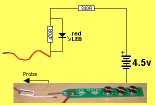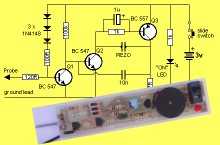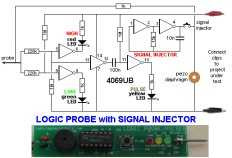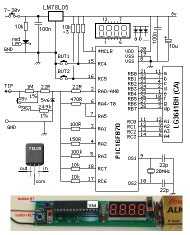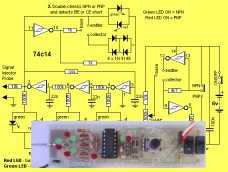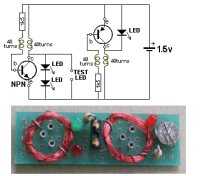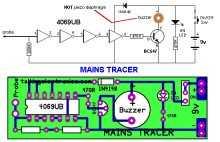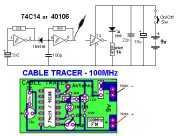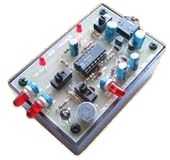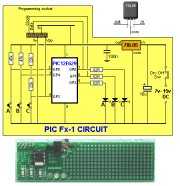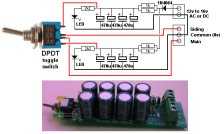Table Of Contents
Through-hole version and Surface Mount version
[Kits are available](mailto:colin@elechelp.com?Subject=Buying Logic Probe with Pulser - slimline kit&Body=Please%20e-mail%20the%20cost%20of%20Logic Probe with Pulser - slimline kit%20by%20air%20mail%20to%20my%20country:****___****%20%20and%20send%20details%20of%20how%20I%20can%20pay%20for%20it.%20My%20name%20is:____) for this project from Talking Electronics
$8.80 for through-hole version
We have 2 versions of this project. Version 1 uses one-eighth watt through-hole resistors and version 2 uses surface-mount components.
You can decide which version you want to build and either one will be an experience.
And the boards now have a mechanical buzzer that produces a much-louder output.
These are all improvements and reflect the availability of components.
The project works the same as before. But the piezo diaphragms are hard to get and very expensive.
A LOGIC PROBE is just one piece of equipment to help with designing/testing and diagnosing a project.
And for $9.00 or $8.80 you can’t pass it up.
It has two features above other Logic Probes. A pulser to produce a waveform that can be injected into a circuit to produce “clocking” or into audio circuits to determine the relative amplification of a stage. And a mechanical buzzer to hear the presence of waveforms.
You won’t be able to listen to very high frequency signals but many signals in a project consist of scanning data and these can be detected as audio.
This project forms part of our overall aim to get you into designing circuits using a microcontroller.
It teaches you how to use a Probe and Pulser and adds to your understanding and analysis of circuits.
You don’t need a Logic Probe until a project DOES NOT WORK.
That’s when you reach for it.
And it is based on a very simple circuit.
It provides all the features you need and will detect HIGH/LOW voltages on 3v to 15v circuits because the power for the Probe comes from the leads clipped to the power rails of the circuit you are testing.
This provides automatic adjustment for HIGH and LOW values to equate to approx 50% of rail-voltage.
The project also has a Pulse LED to show when a single pulse is detected. This is actually a “pulse extender” and is handy for the time when you are waiting for a single pulse to arrive to activate a circuit.
The piezo also monitors the input and you can hear the activity on the line and compare one line with another.
The PULSER mode delivers a low frequency waveform and this will override some of the waveforms in a circuit to slow-down the activation of a circuit to see what is happening.
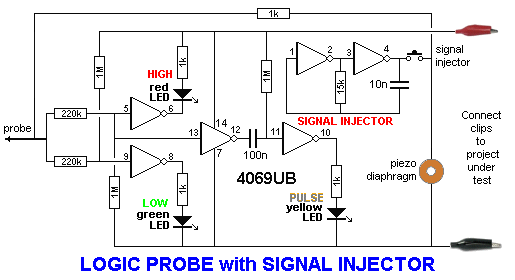
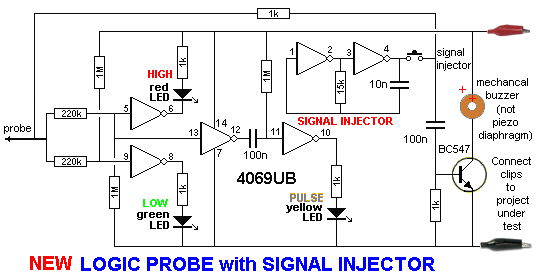
The latest PCB’s use a mechanical buzzer (it contains a transistor and metal diaphragm and
must be connected to the board around the correct way). It is
shown in the circuit above and the images below. It is driven in a very clever
way by a transistor that is AC coupled to the input-line (from the probe). It takes 1k to
discharge the 100n quickly so the transistor reacts to the signal.


This is the Logic Probe using one-eighth watt resistors.
It is available as a kit for $8.80. (the cheapest Logic Probe kit on the market)
This project has already been used to solve the following problems:
No display on the Super Probe MkII project.
The clock pin was injected with the pulser and the Super Probe MkII showed segments on the display at a very low clock-rate to prove the microcontroller was working The problem was one of the 20Mhz crystal leads connected to 0v.
The 8x8 Module did not produce a display. The data and clock lines were probed and it was found the data line was not connected.
The Logic Probe also helped with the input of the Point Controller project to show when the photo transistor changed from LOW to HIGH.
The Logic Probe helped to solve a problem with the Hourglass Timer project. A track was missing !
You don’t realise how many times you use a Logic Probe until you keep a list of the incidents.
The illumination of the LEDs on the Logic Probe tell you a lot of things. They show if a line is predominantly HIGH or LOW and the piezo will let you hear the activity on a low-frequency line. This has helped with the display section of the Stroop and NIM projects.
It won’t solve all your problems, but it will quickly find open tracks (traces) and let you see the signal on each side of components, such as LEDs, that are not connected to the 0v rail (in a multiplexing or Charlieplexing arrangement).
LOGIC PROBE WITH PULSER SLIMLINE - PARTS LIST
for through-hole version
Cost: au$8.80 plus postage[Kits are available**](mailto:colin@elechelp.com?Subject=Buying%20Logic%20Probe%20with%20Pulser%20Slimline%20kit&Body=Please%20e-mail%20the%20cost%20of%20Logic%20Probe%20with%20Pulser%20Slimline%20kit%20by%20air%20mail%20to%20my%20country:****___****%20%20and%20send%20details%20of%20how%20I%20can%20pay%20for%20it.%20My%20name%20is:____)
5 - 1k resistors
1 - 15k resistor
2 - 220k resistors
3 - 1M resistors
1 - 10n SM capacitor
2 - 100n SM capacitor
1 - 3mm red LED
1 - 3mm yellow LED
1 - 3mm green LED
1 - 14 pin IC socket
1 - CD4069UB
1 - BC547 transistor
1 - mechanical buzzer
1 - tactile switch
1 - 20mm x 1.2mm nail for probe
20cm red and black hook-up flex
1 - red alligator clip
1 - black alligator clip
20cm very fine solder
1 - Logic Probe/Pulser PC board - TH
WHY TWO VERSIONS?
We mentioned to a sales outlet that we had a new Logic Probe kit and said it used surface-mount components. He wanted a through-hole version for beginners.
So we have two versions.
The PC board is very small so we had to use very small resistors. The project goes together very easily and if you want to advance to soldering surface-mount, this is the ideal time to start.
You just need a pair of tweezers and a fine tipped soldering iron.
Once you try surface-mount you will be hooked. They are faster to fit and make a much neater result.
USING THE LOGIC PROBE
Connect the red and black alligator clips to the project you are testing.
This will automatically allow the Logic Probe to recognise a HIGH and LOW and a change between these two values.
It is the voltage-level at which the Logic Probe changes from HIGH to LOW or LOW to HIGH that is very important.
It must be very close to 50% of rail voltage.
Suppose you connect the Logic Probe to a 12v supply and work on a 5v microcontroller project.
When the Probe detects a 5v signal, this will only be 5/12 = 40% of the input voltage for the IC on the Probe and it will detect this as a LOW !
That’s why the Probe is always connected to the project being tested.
Use the probe on lots of working projects to see how the LEDs illuminate and the piezo responds to the signals.
This is the only way to find out what to expect.
You must compare your observations with a circuit diagram as this will be your “library of resources” for future diagnosis.
When you are working on a faulty project, you will see the red and orange LEDs brightly lit and the green LED very dull. This indicates the line is mainly HIGH.
If the frequency of the pulses are between 50Hz and 10kHz, you will hear them in the piezo.
USING THE PULSER
The project produces an output waveform of approx 330Hz when the button is pressed.
This can be injected into a circuit to produce lots of different effects.
The waveform is called a PULSER, CLOCK, INJECTOR, OSCILLATOR or SIGNAL INJECTOR, depending on the type of circuit being analysed (and how you want to call it).
It is especially handy when trouble-shooting audio circuits to detect the gain through a stage. Audio stages are very difficult to trouble-shoot, especially when three or more sections are DC coupled. A signal injector will let you know if a signal is getting through as some sections are current amplifiers and the amplitude of the waveform does not increase.
CONSTRUCTION
All the parts fit on a slim-line PC board with surface-mount components used to reduce the size and make to the project appear very simple.

The latest PCB’s use a mechanical buzzer as shown on the two photo’s using through-hole components. The piezo diaphragms became unavailable.

Two more SM parts are on the new PCB to drive the mechanical buzzer.
(They are not shown in this version of the PC board)

All the values of the surface-mount components are identified on the top (silk-screen) and the 10n is the same size as the 100n so don’t get them mixed-up.
LOGIC PROBE WITH PULSER SLIMLINE - PARTS LIST
SURFACE MOUNT VERSION
Cost: au$9.00 plus postage Kits are available
5 - 1k (102) SM resistors
1 - 15k (153) SM resistor
2 - 220k (224) SM resistors
3 - 1M (105) SM resistors
1 - 10n SM capacitor
2 - 100n SM capacitor
1 - 3mm red LED
1 - 3mm yellow LED
1 - 3mm green LED
1 - 14 pin IC socket
1 - CD4069UB
1 - BC547 transistor
1 - mechanical buzzer
1 - tactile switch
1 - 20mm x 1.2mm nail for probe
20cm red and black hook-up flex
1 - red alligator clip
1 - black alligator clip
20cm very fine solder
1 - Logic Probe/Pulser PC board - SM
TEST EQUIPMENT
Talking Electronics has a number of pieces of TEST EQUIPMENT to help in the design and testing of projects.
Of course you can use a multimeter for most of the testing but some of the “tricky” faults need a special piece of equipment.
You may only need a LOGIC PROBE once a month, but the project you are designing will come to a stand-still if you can’t locate a problem.
We designed all these projects because we needed them ourselves.
Add one of them to each order you place with Talking Electronics and eventually you will have the whole range.
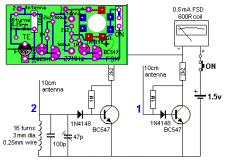
Quick Links
Legal Stuff
Social Media


